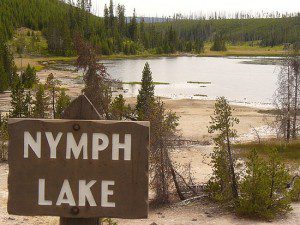

Archaea are single-cell organisms that are similar in size and shape to bacteria, but are evolutionarily and biochemically quite distinct. They inhabit a broad range of environments including those with extreme conditions such as high temperature, acidity, and salinity. Identification of archaeal RNA viruses is important because their study could provide information about the ancestors of RNA viruses that infect eukaryotes. Direct sequencing of viral communities from the environment, known as viral metagenomics, is one approach being taken to discover archaeal viruses.
The acidic (pH <4) and hot (>80°C) springs in Yellowstone National Park were examined for the presence of archaeal RNA viruses because these bodies of water contain mainly Archaea. Samples were obtained from 28 different sites and extracted nucleic acids were treated with DNAase (to remove DNA genomes) and then reverse transcriptase (to copy RNA to DNA). If reverse transcription was reduced by treatment with RNAse, it was concluded that the sample contained mostly RNA. The results narrowed the sample size to three, all from Nymph Lake. New samples obtained twelve months later also showed a predominance of RNA and were used for metagenomic analysis by deep sequencing.
Analysis of the RNA viral sequences revealed coding regions for a predicted RNA dependent RNA polymerase (RdRp), a hallmark of RNA viruses. One assembled sequence of 5,662 nucleotides, believed to be a complete viral genome, encodes a single open reading frame containing a RdRp and a putative capsid protein similar to that of the positive-strand RNA containing nodaviruses, tetraviruses, and birnaviruses. Another viral sequence encoded a protein with 70% amino acid homology to the predicted RdRp. The sequences are from a novel virus which does not belong to any known virus family.
These results clearly show that at least two related but distinct RNA viruses are present in Nymph Lake. However whether or not the hosts of these viruses are Archaea or Bacteria cannot be determined by these metagenomic analyses. What is needed to resolve this question is old-fashioned virology: isolating RNA virus particles that can infect an archaeal host and produce new infectious viruses.
B Bolduc, DP Shaughnessy, YI Wolf, EV Koonin, FF Roberto and M Young J. Virol. 2012, 86(10):5562. DOI: 10.1128/JVI.07196-11.

The morphology of archae Phages are very fascinating. I know there are no EM pics but it wouldnt suprise me if its Rodshaped.
There’s also some newer-fangled ways of seeing what their hosts are: do some proteomics on fairly rudely isolated host bacteria, and look for virus-specific signals, recognised from the sequence. That, and in situ hybridisation – in the fairly likely eventuality that the host bacteria are not culturable.
An interesting alternative way of looking for RNA viruses would be to do dsRNA isolation on concentrated bacteria/archaea: this is a VERY under-appreciated way of very quickly enriching for (+) and dsRNA viruses.